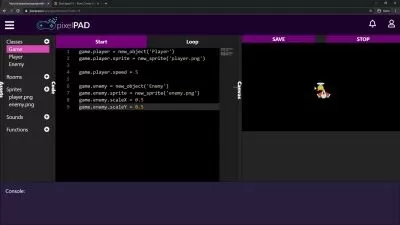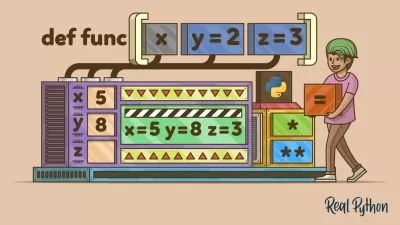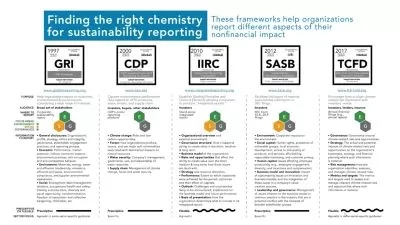Python for Finance: Investment Fundamentals & Data Analytics
365 Careers
8:45:23
Description
Learn Python Programming and Conduct Real-World Financial Analysis in Python - Complete Python Training
What You'll Learn?
- Learn how to code in Python
- Take your career to the next level
- Work with Python’s conditional statements, functions, sequences, and loops
- Work with scientific packages, like NumPy
- Understand how to use the data analysis toolkit, Pandas
- Plot graphs with Matplotlib
- Use Python to solve real-world tasks
- Get a job as a data scientist with Python
- Acquire solid financial acumen
- Carry out in-depth investment analysis
- Build investment portfolios
- Calculate risk and return of individual securities
- Calculate risk and return of investment portfolios
- Apply best practices when working with financial data
- Use univariate and multivariate regression analysis
- Understand the Capital Asset Pricing Model
- Compare securities in terms of their Sharpe ratio
- Perform Monte Carlo simulations
- Learn how to price options by applying the Black Scholes formula
- Be comfortable applying for a developer job in a financial institution
Who is this for?
What You Need to Know?
More details
Description
Do you want to learn how to use Python in a working environment?
Are you a young professional interested in a career in Data Science?
Â
Would you like to explore how Python can be applied in the world of Finance and solve portfolio optimization problems?
Â
If so, then this is the right course for you!
Â
We are proud to present Python for Finance: Investment Fundamentals and Data Analytics – one of the most interesting and complete courses we have created so far.
Â
An exciting journey from Beginner to Pro. Â
If you are a complete beginner and you know nothing about coding, don’t worry! We start from the very basics. The first part of the course is ideal for beginners and people who want to brush up on their Python skills. And then, once we have covered the basics, we will be ready to tackle financial calculations and portfolio optimization tasks. Â
Finance Fundamentals. Â
And it gets even better! The Finance part of this course will teach you in-demand real-world skills employers are looking for. To be a high-paid programmer, you will have to specialize in a particular area of interest. In this course, we will focus on Finance, covering many tools and techniques used by finance professionals daily:Â Â
Rate of return of stocks
Â
Risk of stocks
Â
Rate of return of stock portfolios
Â
Risk of stock portfolios
Â
Correlation between stocks
Â
Covariance
Â
Diversifiable and non-diversifiable risk
Â
Regression analysis
Â
Alpha and Beta coefficients
Â
Measuring a regression’s explanatory power with R^2
Â
Markowitz Efficient frontier calculation
Â
Capital asset pricing model
Â
Sharpe ratio
Â
Multivariate regression analysis
Â
Monte Carlo simulations
Â
Using Monte Carlo in a Corporate Finance context
Â
Derivatives and type of derivatives
Â
Applying the Black Scholes formula
Â
Using Monte Carlo for options pricing
Â
Using Monte Carlo for stock pricing
Everything is included! All these topics are first explained in theory and then applied in practice using Python. This is the best way to reinforce what you have learned. Â
This course is great, even if you are an experienced programmer, as we will teach you a great deal about the finance theory and mechanics you will need if you start working in a finance context.   Â
Teaching is our passion. Â
Everything we teach is explained in the best way possible. Plain and clear English, relevant examples and time-efficient lessons. Don’t forget to check some of our sample videos to see how easy they are to understand. Â
If you have questions, contact us! We enjoy communicating with our students and take pride in responding very soon. Our goal is to create high-end materials that are fun, exciting, career-enhancing, and rewarding.  Â
What makes this training different from the rest of the Programming and Finance courses out there? Â
This course will teach you how to code in Python and apply these skills in the world of Finance. It is both a Programming and a Finance course.
High-quality production – HD video and animations (this isn’t a collection of boring lectures!)
Knowledgeable instructors. Martin is a quant geek fascinated by the world of Data Science, and Ned is a finance practitioner with several years of experience who loves explaining Finance topics in real life and on Udemy.
Complete training – we will cover all the major topics you need to understand to start coding in Python and solving the financial topics introduced in this course (and they are many!)
Extensive Case Studies that will help you reinforce everything you’ve learned.
Course Challenge: Solve our exercises and make this course an interactive experience.
Excellent support: If you don’t understand a concept or you simply want to drop us a line, you’ll receive an answer within 1 business day.
Dynamic: We don’t want to waste your time! The instructors set a very good pace throughout the whole course.
Please don’t forget that the course comes with Udemy’s 30-day unconditional, money-back-in-full guarantee. And why not give such a guarantee, when we are convinced the course will provide a ton of value for you?
Click 'Buy now' to start your learning journey today. We will be happy to see you inside the course.
Who this course is for:
- Aspiring data scientists
- Programming beginners
- People interested in finance and investments
- Programmers who want to specialize in finance
- Everyone who wants to learn how to code and apply their skills in practice
- Finance graduates and professionals who need to better apply their knowledge in Python
Do you want to learn how to use Python in a working environment?
Are you a young professional interested in a career in Data Science? Â
Would you like to explore how Python can be applied in the world of Finance and solve portfolio optimization problems? Â
If so, then this is the right course for you! Â
We are proud to present Python for Finance: Investment Fundamentals and Data Analytics – one of the most interesting and complete courses we have created so far. Â
An exciting journey from Beginner to Pro. Â
If you are a complete beginner and you know nothing about coding, don’t worry! We start from the very basics. The first part of the course is ideal for beginners and people who want to brush up on their Python skills. And then, once we have covered the basics, we will be ready to tackle financial calculations and portfolio optimization tasks. Â
Finance Fundamentals. Â
And it gets even better! The Finance part of this course will teach you in-demand real-world skills employers are looking for. To be a high-paid programmer, you will have to specialize in a particular area of interest. In this course, we will focus on Finance, covering many tools and techniques used by finance professionals daily:Â Â
Rate of return of stocks Â
Risk of stocks Â
Rate of return of stock portfolios Â
Risk of stock portfolios Â
Correlation between stocks Â
Covariance Â
Diversifiable and non-diversifiable risk Â
Regression analysis Â
Alpha and Beta coefficients Â
Measuring a regression’s explanatory power with R^2 Â
Markowitz Efficient frontier calculation Â
Capital asset pricing model Â
Sharpe ratio Â
Multivariate regression analysis Â
Monte Carlo simulations Â
Using Monte Carlo in a Corporate Finance context Â
Derivatives and type of derivatives Â
Applying the Black Scholes formula Â
Using Monte Carlo for options pricing Â
Using Monte Carlo for stock pricing
Everything is included! All these topics are first explained in theory and then applied in practice using Python. This is the best way to reinforce what you have learned. Â
This course is great, even if you are an experienced programmer, as we will teach you a great deal about the finance theory and mechanics you will need if you start working in a finance context.   Â
Teaching is our passion. Â
Everything we teach is explained in the best way possible. Plain and clear English, relevant examples and time-efficient lessons. Don’t forget to check some of our sample videos to see how easy they are to understand. Â
If you have questions, contact us! We enjoy communicating with our students and take pride in responding very soon. Our goal is to create high-end materials that are fun, exciting, career-enhancing, and rewarding.  Â
What makes this training different from the rest of the Programming and Finance courses out there? Â
This course will teach you how to code in Python and apply these skills in the world of Finance. It is both a Programming and a Finance course.
High-quality production – HD video and animations (this isn’t a collection of boring lectures!)
Knowledgeable instructors. Martin is a quant geek fascinated by the world of Data Science, and Ned is a finance practitioner with several years of experience who loves explaining Finance topics in real life and on Udemy.
Complete training – we will cover all the major topics you need to understand to start coding in Python and solving the financial topics introduced in this course (and they are many!)
Extensive Case Studies that will help you reinforce everything you’ve learned.
Course Challenge: Solve our exercises and make this course an interactive experience.
Excellent support: If you don’t understand a concept or you simply want to drop us a line, you’ll receive an answer within 1 business day.
Dynamic: We don’t want to waste your time! The instructors set a very good pace throughout the whole course.
Please don’t forget that the course comes with Udemy’s 30-day unconditional, money-back-in-full guarantee. And why not give such a guarantee, when we are convinced the course will provide a ton of value for you?
Click 'Buy now' to start your learning journey today. We will be happy to see you inside the course.
Who this course is for:
- Aspiring data scientists
- Programming beginners
- People interested in finance and investments
- Programmers who want to specialize in finance
- Everyone who wants to learn how to code and apply their skills in practice
- Finance graduates and professionals who need to better apply their knowledge in Python
User Reviews
Rating
365 Careers
Instructor's Courses
Udemy
View courses Udemy- language english
- Training sessions 132
- duration 8:45:23
- English subtitles has
- Release Date 2023/09/10



















